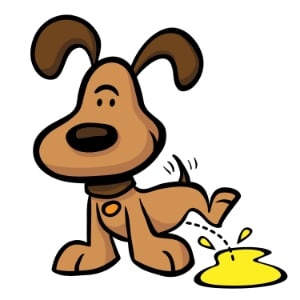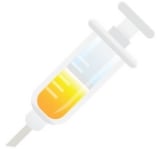 Are you noticing any concerning changes in your dog’s urinations? Are you noticing blood in their urine?
Are you noticing any concerning changes in your dog’s urinations? Are you noticing blood in their urine?
Are they suddenly peeing more often? Are they now peeing in your house, or straining to pee?
Or perhaps it’s not even their urinations, but rather an increase in their water drinking that you’ve recently noticed?
Or maybe it’s weight loss, vomiting, or something else entirely that’s suddenly changed in your dog?
You’ve likely (hopefully) recognized that each of these situations are cause for a trip to the vet, but are you aware of the important role your dog’s urine might play in helping you and your vet figure out the underlying cause in all of these situations?
Yes, that’s right… even in cases of vomiting, weight loss, and many other situations that seem to have absolutely no connection to your dog’s urinary system!
Make your dog cross their legs before going to the veterinarian
You see, whatever problem you’re bringing your dog to the vet for, or even when it’s just for a routine wellness check-up, that urine your dog is so cavalierly disposing of (perhaps even on your carpets, or burning up your lawn) could actually be the thing that helps your vet diagnose the underlying problem or, in the case of a wellness check-up, confirm your dog's good health.
In many situations, the importance of a urinalysis and/or a urine culture cannot be overstated. And since my super-intelligent friend and colleague, Dr. Ann Hohenhaus of The Animal Medical Center in New York City, wrote a great post on this very topic, I’ll leave it to her to explain all the information and value that we vets and pet owners get from a few simple urine tests.
The purpose of this post is to share with you some tricks and tips to help you make sure that your vet can get the urine they need to provide you with the best information, advice, and treatment for caring for your dog.
How to keep your dog from urinating within the few hours prior to their veterinary visit
- If they’re small enough to comfortably do so, carry your dog from the car into your vet’s office.
- If they’re too heavy to carry, run with your leashed dog from the car into your vet’s office, don’t give them a chance to sniff and pee.
- Don’t let your dog out into your yard unattended prior to their vet visit. If they must go out, go with them, have them on a leash and collect their urine (see tricks and tips below).
- The veterinary team will collect a fresh sample during your appointment, so having your dog’s bladder full is helpful.
How to collect your dog's urine sample from home, if preventing pre-visit urination isn’t possible or practical
- Try to get as fresh a sample as possible (ideally within a few hours of your dog’s appointment). Veterinarians will typically request a urine sample from your dog's first urination of the morning.
- With your dog on a leash and your collection vessel (glass or plastic, shallow Tupperware-type container or a soup ladle) in hand, take your dog outside. (Suggestion: use a container that you don’t care about getting back!)

- Keep your dog close to you and pay close attention — never use a retractable leash and don’t be checking your emails or chatting on your phone — the moment can come and “go” quickly!
- When your dog squats or lifts their leg to pee, carefully place your collection container into their urine stream and gather a sample of their pee. Try to get the sample midstream. Immediately cover the container after collection so as not to contaminate or spill it. That’s it, easy peasy… most of the time, at least.
- In some cases, this may be a 2-person job or you might have to try several attempts, especially if your hound gets “stage fright” or startled when you place the container under them. Here’s a short video from the staff at Animal Hospital of Ashwaubenon in Green Bay, WI demonstrating this home urine collection process.
A special note for collecting urine from pee pad-trained dogs: You can actually extract freshly voided urine from a clean pee pad using a syringe.
Ask your vet for a clean 6 or 12mL syringe (no needle necessary) and place the syringe tip firmly into the urinated on area of the pee pad and pull back on the plunger of the syringe. Voila… urine sample in a syringe all ready for transport to your vet!
Keep the Urine In the Fridge
Once collected, be sure to keep the sample on ice in a cooler or in the fridge if you won’t be taking it directly to your vet. Ideally, it should be delivered to your veterinarian within a couple of hours after collection. This helps to ensure the most reliable and accurate results of the testing.
Be sure to ask your veterinary team how long a urine sample can be stored if you know that you cannot get it to them directly after collection. And inform your veterinarian if you have stored the sample in the fridge or cooler, as it will need time to return to room temperature for testing.
If You Can't Get a Urine Sample from Your Dog
If your dog or puppy has snuck in a pee prior to arrival at your vet’s office or if you were unable to collect a sample yourself, don’t worry too much, it’s not the end of the world. If your vet needs urine to complete their diagnostic profile, there are still a couple of tricks they and their team will likely still have up their sleeve for getting the necessary sample.
If they have an ultrasound machine in their office they may use it to help find your dog’s (now smaller) bladder and extract a sterile urine sample directly from the bladder with a small needle (a common procedure called cystocentesis, more often abbreviated to just cysto).
If you’ve got a male dog, your vet could also pass a sterile (soft) catheter directly up your dog’s urethra into their bladder to retrieve the sample. (This catheterization procedure is particularly useful if your dog hasn’t been neutered or if there is any concern that your dog may have a urinary obstruction. It can also be done in a female dog, but it’s a bit more involved and complicated.)
Finally, if the urine concentrating ability of your dog’s kidneys isn’t a crucial piece of information your vet is looking for at that particular time, your vet may also give your dog a dose of subcutaneous (under the skin) fluids and sit him in a cage for a few hours while those fluids work their way through your dog’s kidneys and arrive in their bladder as urine. They can then collect the necessary urine sample either via “free catch” or “cysto”/“catheterization,” as described above.
Speaking of “free catch,” “cysto,” and “catheterization” urine samples… here’s some info about what the terms mean and why/when your vet might prefer one collection method over another.
- Free catch urine samples, the type you can collect at home, are great and perfectly fine in most cases.
- However, when your veterinarian is concerned about the possibility of a urinary tract infection (UTI), they’ll most likely want to collect either a cysto or catheterized sample, if possible. The reason for this is that since the cysto sample is taken directly from your dog’s bladder there is no concern of contamination of the sample from your dog’s fur or genetalia, which often happens with a free catch sample and could otherwise interfere with or skew the results of the urine culture which your veterinarian will likely wish to have run on the urine.
So, there you have it — a bit about the importance of the urine sample and how you can go about collecting it (or helping to make sure that your vet can).
If your dog tends to be nervous about going to the vet check out this article for some tips to help calm him down and make the visit with your vet easier on your pooch.






